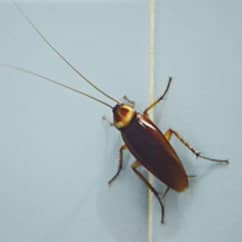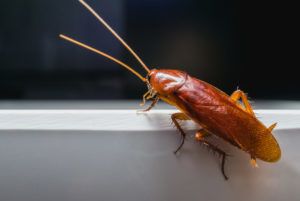American Cockroaches
WHAT IS AN AMERICAN COCKROACH?
They generally live outdoors in warm, moist areas like under mulch, log piles and under flower beds but will make their way indoors to look for food and water.
WHAT DO THEY LOOK LIKE?
Adults can grow to be more than 2 inches in length; they are generally a reddish-brown to mahogany color. The area behind their head has a yellow band around it; they also have fully developed wings and are able to fly.
DO AMERICAN COCKROACHES BITE?
They are capable of biting but rarely, if ever, do. If bitten it should not present a problem unless the bite becomes infected.
ARE AMERICAN COCKROACHES DANGEROUS?
While they do not bite or sting they do feed and live in areas that harbor dangerous bacteria, such as bathrooms, drains, and dumpsters. The American cockroach (like other roaches) carries the bacteria on their body and can contaminate food as well as areas where food is prepared. The bacteria can cause vomiting, fever, diarrhea and even transmit Salmonella. This type of roach sheds its skin and leaves excrement behind and in some people the allergens from those will cause severe asthma attacks.
WHAT ARE SIGNS OF AN AMERICAN COCKROACH INFESTATION?
American cockroaches are mostly active at night when they are foraging for food and water. During the day they will hide in cracks and crevices in walls and through the home or business they are infesting. If there is a heavy population you may see them scurrying around or even flying about during the day when disturbed. You may also find their feces in kitchen areas inside the drawers and cabinets, behind appliances and in basements, their excrement resembling coffee grounds. They also secrete an odor that may cause a musty smell in the area they are infesting.

EVERY HOMEOWNER SHOULD KNOW ABOUT COCKROACHES
What You Don’t Know Can Hurt You
There are some pretty interesting facts you can learn about cockroaches by searching the internet. You can find out that cockroaches can resist high levels of radiation and that they are likely to be one of the few creatures that will survive a global thermonuclear war. You can learn that drowning a cockroach is extremely difficult because they can hold their breath for over a half an hour, or that a roach can survive for around a week without its head because it breathes through its body. While these are neat facts, they’re not going to help you protect your family from these dirty pests–but here are some that will.
Cockroaches Are A Health Threat
We all know cockroaches are filthy but you might not know the half of it. Are you aware that cockroaches are linked to the spread of 33 kinds of bacteria, 2 of the most widely recognizable being Salmonella and E. coli? When these insects get into a man-made structure, that quickly presents a health risk.
Do you know that cockroaches can spread 6 types of parasitic worms? They go by names like tapeworm, roundworm, hookworm, pinworm, whipworm, and other variations of these. When cockroaches get into stored food, they can do more than taint it in a way that will cause diarrhea or vomiting. They can introduce these worms which are able to live in the intestinal tract of humans and create a whole host of medical issues.
Cockroaches Are Resourceful
A roach can compact its body to squeeze through gaps much thinner than their height. They can scale walls and walk across ceilings that seem smooth to the naked eye. Some roaches are even able to fly. If you’re trying to keep this insect out of your home, you’re going to have a hard time doing it without some form of pest control product. And, when cockroaches get inside, newly hatched roaches can be small enough to slip through the holes in your wall outlet. That means, they’re going to have no problem spreading.
Cockroaches Are Hard To Kill
Radiation isn’t the only thing that cockroaches are able to resist. They have the ability to grow a tolerance for pesticides. This resistance to insecticide makes them a challenge to control without training and experience in modern pest management protocols. Plus, killing cockroaches doesn’t arrest a cockroach infestation. You can kill cockroaches all day, every day, and still have these insects crawling around inside your home.
Reasons You May Find Roaches in Your Home and How to Prevent It
Not only can spotting a roach in your home be an unsettling sight, but it may even be a sign of an underlying infestation. If not properly eliminated from your home, roaches are a persistent pest that can easily multiply when living in the right environment. Regardless of how many times you’ve cleaned your home, you just can’t seem to get rid of them
What Are the Signs of a Cockroach Problem?
Cockroaches are nocturnal pests, meaning that you most likely see signs of an infestation during the day. During the day, cockroaches will hide away in exposed cracks or any other secure hiding places that your home may provide.
The good news is that while you may not spot a live roach during the daytime, you can find other signs of an infestation when the sun is up. These signs include:
Roach droppings (this looks like spilled grounds of coffee)
Bodies of dead roaches
Egg casings that have an oval shape
Why Are There Roaches in My Clean Home?
Roaches aren’t picky visitors when it comes to finding a sustainable home for them to survive and reproduce in.
A Collection of Trash
A great way to make sure that roaches don’t continue to breed in your home is to remove all exposed trash from your home. Cockroaches love to breed on newspapers and cardboard boxes.
Non-Toxic Tips for Ridding Your Home of Roaches
Finding roaches in your home is never fun, and getting rid of them can be quite the chore. If you’ve got a bad infestation, you’ll likely have to call in a professional exterminator to wipe out the problem, but what if you’re just seeing the occasional bug in the kitchen? Most store-bought sprays and traps are full of toxic ingredients, so if you’ve got pets or kids, dealing with roaches is especially concerning. Fortunately, there are natural, safe ways to rid your home of roaches and keep them from coming back.
Sprinkle Diatomaceous Earth
Diatomaceous earth is a white powder made from the fossilized remains of diatoms, which are a type of unicellular, hard-shelled algae. It’s found in many common household products, and if you buy food grade diatomaceous earth, it’s safe for pets and people—just not for roaches, as the powder destroys their exoskeletons. Once you’ve thoroughly cleaned your apartment and cleared or sealed up any possible roach food sources like crumbs, trash, or easily accessible pet food, mix a little cocoa powder or flour with the diatomaceous earth, and lightly dust it where you’ve seen roaches in your home to get rid of them. Roaches will also take the bait back to the nest to feed others, fighting your pesky pest problem at the source.
Spray Essential Oils
Research has found that some essential oils—especially peppermint oil—are effective at repelling roaches. Peppermint oil can also be used as a natural insecticide, although not in the same ways as diatomaceous earth. Leaving mint oil out or spritzing it around won’t kill roaches that come in its path, rather, it’ll just keep them away. But if you spray a peppermint oil on a roach when you see one, it can be an effective and natural alternative to using commercial roach sprays. To repel roaches, try mixing two parts water with one part white vinegar and 10 drops of peppermint oil to a spray bottle, and spritz it around the affected areas of your apartment.
Strategically Place Catnip
That’s right, your feline friend’s favorite herb is actually a natural roach repellent. Roaches are sensitive to the chemical nepetalactone, which is the active ingredient in catnip. (Catnip is also a member of the mint family, so this should come as no surprise!) Placing small satchels of catnip around the areas of your home where you’ve seen roaches should keep them at bay. Catnip won’t kill roaches, but it’s a great option for preventing them from coming back after you’ve finally gotten rid of them.

Cockroaches – pest control
Cockroaches belong to the insect order Blattodea. There are over 4000 species of cockroaches worldwide, only a few of which are considered major pests. The high pest status of cockroaches is largely attributed to their wide distribution, close association with humans and potential to carry disease.
The faeces of some species of cockroach contain a pheromone. These cockroaches press or smear their faeces onto surfaces to mark feeding and aggregation sites.
Conditions that favour cockroach infestations are those that provide abundant food, water and shelter. Cockroaches eat virtually any animal or vegetable material, including paper, fabric, leather, starches and grease particles.
Cockroaches are generally nocturnal. Any active cockroaches observed during the day are often indicative of a large infestation. Cockroaches are gregarious (they congregate together), and frequently groom themselves. This behaviour is exploited by pesticides such as dusts that come in contact with the feet or body of the cockroach and are ingested during grooming.
Cockroach eggs are enclosed in a purse-shaped egg case, which may be carried, dropped or glued to a surface. When hatched, the nymphs congregate with adult cockroaches and mature after a number of moults. The number of nymphal moults, time taken for maturation and the adult lifespan depends on the species of cockroach.